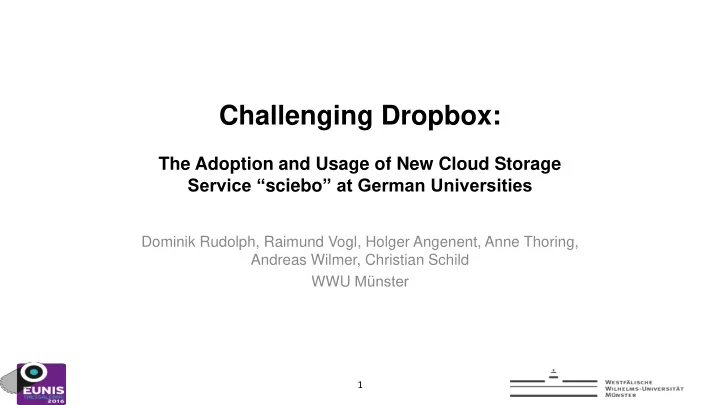

Challenging Dropbox: The Adoption and Usage of New Cloud Storage Service “ sciebo ” at German Universities Dominik Rudolph, Raimund Vogl, Holger Angenent, Anne Thoring, Andreas Wilmer, Christian Schild WWU Münster 1
Academia & Cloud Services Advantages of cloud services • Worldwide accessibility of data • Most recent versions of documents on all devices • Easy exchange and collaboration Concerns about commercial providers • Data security (sensitive research results, confidential information on grades, exams, assessments etc.) • Terms of use grant operators extensive rights • Locations abroad with less strict data protection laws • Commercial interests 2
Academia & Cloud Services What is sciebo? Sciebo (“science box”) is a secure sync & share cloud storage service for academic research and education in North-Rhine Westphalia (NRW). • 5.000.000 GB storage volume • 2.800.000 € public grants • 250.000 potential users – 50.000 by now • 30 GB+ storage volume for each user • 25 participating institutions • 3 data center sites at universities • Launch: 02.02.2015 3
Research Focus Research questions How has sciebo developed during the first year of service in terms of … ? • Adoption, compared with the assumptions of Diffusion Theory • Usage (storage demand, bandwidth) • Performance 4
Predictions I Adoption • The diffusion of sciebo will follow the diffusion curve according to Rogers. • Due to relative advantages and users’ knowledge of the technology sciebo will diffuse faster than Dropbox (within their respective populations). Usage Storage demand • Each user will need an average storage volume of 8 GB (pessimistic scenario) to 16 GB (optimistic scenario). A maximum storage space of 30 GB will fit most users. • Growth will be quite linear, with a 30 percent basis synchronization at the beginning and just small gain of 3 percent a month. 5
Diffusion of Innovations Adopter categories (Rogers 2003) 6
Diffusion of Innovations Diffusion of Dropbox (Dropbox 2016) 7
Predictions II Usage Bandwidth • According to an optimistic scenario, the estimated internet connection bandwidth required for service operation will be 3 Gbps (approx. 1 GB for each site). Performance • Availability scores will be 99.5% per year for each of the sites with a minimum of 98% per month. 8
Adoption Diffusion of sciebo after one year of service 9
Adoption Diffusion curves of chosen universities with the same size starting Feb 2015 10
Usage Storage load on individual user basis per time vs. model 11
Usage Bandwidth 12
Performance Availability scores (in %) for the tree sites hosting sciebo Site A Site B Site C Jan 2016 99.76 100.00 99.93 Feb 2016 99.16 99.66 99.56 Mar 2016 95.69 99.91 98.52 Apr 2016 99.99 100.00 98.93 Mar 15 – Apr 16 99.41 99.81 99.68 13
User Evaluation (recent work) Users’ trust in sciebo (n=4,572) 100% 80% 72,6% 60% 40% 17,5% 20% 8,2% 1,4% 0,3% 0% Uneingeschränkt Gar nicht Eher nicht Teils, teils Eher ja Absolutely Mostly Neither Mostly Absolutely no no yes or no yes yes 14
User Evaluation (recent work) Users’ overall evaluation of sciebo (n=4,645) 0,3% 2,2% 8,0% 36,3% Sehr schlecht Very poor Schlecht Poor Unentschieden Fair Gut Good Very good Sehr gut 53,2% 15
User Evaluation (recent work) Users’ overall evaluation of different cloud services (comparison of means) (n.min=365, n.max=12.754, without n.total) 5 4,23 4,01 3,95 3,91 4 3,70 3,69 3,59 3 2 1 sciebo Dropbox iCloud GoogleDrive OneDrive Amazon Cloud Gesamt Total Drive 16
Conclusion • Diffusion speed depends on: • share of technophiles within the institution • marketing measures • no influence of organization size measurable • Fast growth • System performance and availability: targets met • High trust and user satisfaction 17
Recommend
More recommend